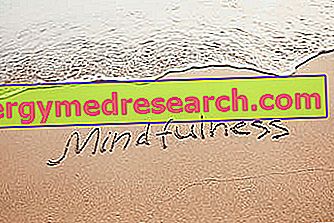Watch the video
X Watch the video on youtubeBlood glucose is the amount of glucose in the blood.
Both the deficiency (called hypo-glycemia) and the excess (called hyperglycemia) of glucose in the blood can be very harmful.
Excess is less symptomatic than the defect. However, in the long term, chronic hyperglycemia causes even serious metabolic complications.

Blood glucose can be measured with a laboratory test or with the help of a glucometer. The units of measurement are: milligrams per deciliter (mg / dl) and millimoles per liter (mmol / l).
The normal range is between 70-99mg / dl. The blood sugar level that reaches and goes beyond is defined as high:
- the 100mg / dl in fasting,
- 200mg / dl after a big meal
- i 140mg / dl after an oral glucose load (specific analysis).
Chronic high blood sugar can cause various problems (atherosclerosis, vasculopathies, etc.), especially when it evolves into type 2 diabetes mellitus.
The causes of hyperglycemia can be behavioral, environmental and genetic.
What to do
When you feel the symptoms of very high blood sugar (tiredness, intense thirst, polyuria, slow healing of wounds, etc.) it becomes necessary:
- Contact your doctor for:
- Visit and assessment of risk factors.
- Blood analysis.
- Examination of the glucose loading curve.
- A specific drug therapy.
- Contact a dietician for a food therapy against high blood sugar.
- If useful or necessary, take supplements or other natural remedies against high blood sugar.
- Practice constant motor activity.
- In case of overweight, lose weight.
- Reduce other cardiovascular risk factors:
- Obesity.
- Hypertension.
- Hypercholesterolemia.
- Hypertriglyceridemia.
- Oxidative stress.
What NOT to do
- Ignore the symptoms described above.
- Ignore medical prescriptions.
- Skip routine blood sugar checks; in some cases, this value must be measured daily.
- Follow an unbalanced or recommended diet from sources of dubious professionalism.
- Adopt a sedentary lifestyle.
- Grease or stay overweight.
- Maintain unchanged or increase cardiovascular risk factors.
What to eat
Diet is a fundamental tool to fight high blood sugar.
The fundamental principles are:
- In case of overweight, follow a low-calorie slimming diet.
- Reduce portions of carbohydrate-rich foods:
- Cereals and derivatives (pasta, bread, etc.).
- Potatoes.
- Dehulled legumes.
- Sweet fruit.
- With reference to the previous ones, choose those with a low glycemic index:
- Whole and dietary cereals and derivatives (enriched with soluble fibers such as inulin).
- Whole legumes.
- Little or medium sweet fruit.
- Further lower the glycemic load of meals:
- Increasing the number of meals (at least 5 and up to 7).
- Reducing the calories of each meal.
- By reducing the individual portions of foods rich in carbohydrates and distributing them in all meals (except for the one that precedes sleep).
- Further lower the glycemic index of meals:
- Increasing the intake of dietary fiber from low-calorie vegetables (radicchio, lettuce, zucchini, fennel, etc.).
- Always using extra virgin olive oil to season: fats tend to slow down digestion and absorption of sugars enough to avoid the glycemic surge.
- Always associate a modest portion of protein-rich foods (chicken breast, cod fillet, egg, lean ricotta, light milk flakes etc.): for the same reason described above.
- If the aptitude to drink small quantities of alcohol is present, prefer red wine. Too much alcohol is not good; however, it is shown that small portions can reduce blood sugar levels.
- Consume foods rich in good fatty acids, especially omega 3:
- Eicosapentaenoic and docosahexaenoic acid (EPA and DHA): biologically the most active of the omega 3 family. They are contained in fishery products and algae. They play a protective role against all metabolic pathologies and significantly reduce the imbalances created by high blood sugar. The foods that contain the most are: Sardinian, mackerel, bonito, alaccia, herring, alletterato, ventresca of tuna, needlefish, algae, krill etc.
- Alpha linolenic acid (ALA): it is less active from a biological point of view but has the same function as the previous ones. It is found mainly in the fat fraction of certain foods of vegetable origin or in the oils of: soy, linseed, kiwi seeds, grape seeds, etc.
- Eat foods rich in vitamin antioxidants; play a protective effect against free radicals fighting oxidative stress (strongly related to high blood sugar):
- Vitamin E provitamine A: are contained in vegetables and red or orange fruits (apricots, peppers, melons, peaches, carrots, squash, tomatoes, etc.); they are also present in shellfish and milk.
- Vitamin C: it is typical of acidulous fruit and some vegetables (lemons, oranges, mandarins, grapefruit, kiwi, peppers, parsley, chicory, lettuce, etc.).
- Vitamin E: it is found in the lipid portion of many seeds and related oils (wheat germ, maize germ, sesame, etc.) as well as in vegetables.
- Prefer foods rich in non-vitamin antioxidants: these are mainly polyphenols (simple phenols, flavonoids, tannins). Oxidative stress will further moderate and optimize metabolic parameters; moreover, they also act as anti-nutritional agents, reducing the digestibility of carbohydrates. They are mainly contained in: vegetables (onion, garlic, citrus fruits, cherries, etc.), fruit and related seeds (pomegranate, grapes, berries, etc.), wine, oilseeds, coffee, tea, cocoa, legumes and whole grains, etc.
- Respect a fairly large amount of time between the last meal of the day and the following breakfast. Some studies report that increasing the fasting time can improve blood glucose levels. Obviously, this trick should not conflict with the principle of nutritional distribution.
What NOT to Eat
- High-calorie foods, especially packaged, fast-food, sweets and other "junk foods".
- Excessive portions of food with a predominance of carbohydrates (pizza, bread, pasta, potatoes, etc.).
- Foods with high glycemic index (refined and boiled cereals, bread crust, very sweet fruit juice, sweet snacks, etc.).
- Meals too abundant.
- Totally dissociated meals (only based on carbohydrates, only based on fats, only based on proteins).
- ONLY protein-rich or high-fat foods; some are led to believe that carbohydrates need to be eliminated to cure high blood sugar. If it is true that this choice would facilitate the reduction of blood sugar, it is equally true that chronic high blood sugar can affect the functionality of certain organs and compromise its functionality. In the diabetic decompensated by high blood sugar, sometimes the kidneys cannot bear the excess of proteins and ketone bodies.
- Beer, sugary drinks and sweet liqueurs.
- Foods rich in bad fats, that is:
- Saturated lipids: mainly contained in fatty cheeses, cream, fatty cuts of meat, sausages and cured meats, hamburgers, frankfurters, bifractionated oils (palm kernel, palm etc.).
- Hydrogenated lipids and especially in trans conformation: mainly contained in hydrogenated oils, margarines, sweet snacks, salty snacks, packaged baked goods, etc.
- Eat poor or depleted foods of vitamin and polyphenolic antioxidants:
- Only cooked vegetables.
- Only preserved vegetables (canned, dried, salted, pickled, in oil etc.).
Natural Cures and Remedies
The most effective natural remedies for lowering high blood sugar are:
- Diet: includes everything we have already discussed in the paragraphs of what to eat and what to avoid.
- Motor activity: it is the best system to reduce the amount of sugar in the blood and to improve metabolic efficiency. In fact, physical training (especially aerobic with high intensity peaks) also positively affects hormonal sensitivity, improving blood sugar levels even at rest. In addition, it promotes weight loss (a factor directly implicated in the appearance of high blood sugar).
- Medicinal plants: there are various plants to which hypoglycemic abilities are attributed; these can be used as herbal tea or in mother tincture:
- Eucalyptus: has a hypoglycemic effect thanks to the richness in antioxidant polyphenols (including tannins), which hinder the digestion and absorption of carbohydrates.
- Myrtle: is an inhibitor of the intestinal digestive enzyme alpha-glucosidase.
- Elderberry: the terpenoids and phytosterols (beta-sitosterol) contained in its inflorescences have an insulin-stimulating action, therefore hypoglycemic.
- Galega officinalis : the seeds contain galegina (hypoglycemic alkaloid) which enhances insulin action, improves muscle glucose uptake, reduces the hepatic mechanism of glycogenolysis and pancreatic glucagon production. The galega should be used under strict medical supervision; fresh can be toxic.
- Opuntia: contains mannans, or polysaccharides that hold sugars in the intestinal lumen, blocking its absorption.
- Gymnema: its leaves contain gymnemic acids, glycosidic acids that reduce the intestinal absorption of glucose and stimulate the activity of pancreatic beta cells in the production of insulin.
- American Ginseng: not to be confused with Korean, it reduces the absorption of carbohydrates, promotes the release of insulin and increases the tissue uptake of glucose.
Pharmacological care
- Biguanids (ad es metforal and glucophage): they are based on metformin, a molecule that reduces hepatic gluconeogenesis and moderates the intestinal absorption of sugar.
- Acarbose (eg glicobasey and glucobay): reduces the absorption of carbohydrates but often causes side effects of gastrointestinal type.
- Thiazolidinediones (eg, actos, glustin): they promote the use of glucose and optimize fat metabolism by increasing insulin action.
- Glinids (ad es novonorm, prandin, enyglid etc.): they work like sulfonylureas, that is they stimulate the production of insulin.
- pramlintide
- : increases digestion time and carbohydrate absorption, reduces glucagon secretion and stimulates satiety.
- Mimetics of incretins (ad es byeta, victoza, ristaben, xelevia, januvia etc.): they enhance the activity of GLP-1, thus reducing glucagon secretion and stimulating insulin. They slow down digestion and promote satiety.
Prevention
Prevention of high blood sugar is especially necessary in the event of heredity; includes:
- Maintenance of the normal weight.
- Periodic and systematic glycemic control.
- Performing a motor activity.
- Balanced diet characterized by a moderate glycemic load and index.
- Prevention of other metabolic disorders and various related complications.
Medical Treatments
There are no medical treatments for high blood sugar besides the ones already described:
- Motor activity.
- Diet.
- Supplements.
- Drugs.



